| 137
|
CHAPTER 23
Helping José Walk
and Talk after His Stroke

JOSÉ, who is 48 years old, was brought to PROJIMO by
his concerned wife and son. Six months before, he had had a stroke (cerebral
vascular accident) that paralyzed his right side. At first he could not walk
or talk. Weeks later he began to walk with much difficulty, using a cane.
But his speech did not return. He had trouble expressing his wishes. He got
angry with his wife when she did not understand him - and she would get
angry with him. She thought his inability to speak came from weakness of his
mouth, and that if he could learn to move his lips and tongue better he
would be able to talk. She was sure he understood everything she said to
him, and was irritated that at times he didn't respond appropriately.
Fortunately, when José first visited PROJIMO, Ann Hallum, a visiting
physical therapist, was there facilitating a course to help up-grade the
village team's knowledge and skills.

CAUSES OF LANGUAGE PROBLEMS. Ann explained that, after a
stroke, difficulty with speech and communication can be caused by a
combination of problems, depending on the area of the brain that was injured
(by stroke, illness or injury), Injury to one area of the brain's "language
center" can prevent the person from understanding the spoken or written word
(receptive aphasia). Damage in another language area can prevent
her from recalling or forming words or phrases correctly, either in spoken
or written form (expressive aphasia). Persons with severe language
problems may have losses both in receiving and in expressing language (total
aphasia).
José's right-sided paralysis meant that his left brain (with the
"language center") was damaged. Simple testing was needed to find out the
causes of his difficulties with communication.
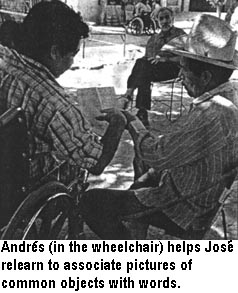
TESTING JOSÉ'S UNDERSTANDING OF LANGUAGE. To test how
well José could associate words with the things they represent, a PROJIMO
worker, Andrés, put a number of objects - a carrot, a spoon, a tomato and a
cup - in front of him. Andrés said, "Give me the carrot." José looked at the
different objects a long time, then picked up the carrot. Everyone clapped
and praised him. However, with the other objects he had more difficulty, and
often made mistakes. When Andrés said, "Give me the tomato," José pondered a
long time, then handed him the spoon.
Further testing showed that although José had a lot of trouble with nouns
(things), he was much better with verbs (action words). Often he would
understand a noun when it was used in a phrase involving a familiar action.
For example, when Andres asked him to pick his sombrero (hat) from several
objects on the table, he was confused. But when Andres said, "Take off your
sombrero," José gave a sigh of understanding and at once took off his hat.
These findings gave clues to how his family might communicate
more effectively with José. It helped his wife understand why he
often did not respond appropriately to her questions; why he would grunt
"Yes!" when she asked, "Do you want a cup of coffee?" and then get upset and
frustrated when she brought him coffee. |
| 138
|
| Sometimes, when José wanted to say
something, he would repeat the word "Burro!" (donkey) many times. This
used to make his wife angry. But when, during the testing, she saw his
confusion with names of things, she gained more understanding of his
problem. During the testing, it became clear that José
had difficulty with names of things. But when his mistakes were clearly
pointed out, he learned fairly quickly. When he was asked to pick up the
spoon, but took the tomato, Andrés would say to him, "No, that is not a
spoon, It is a tomato." After 2 or 3 repeats, José would usually pick up
the spoon when asked.
Helping José to Talk
A PICTURE BOARD FOR BETTER COMMUNICATION. Because one
of José's biggest difficulties with language was recognizing the names of
things, Andrés and others sat down with José and his wife and drew up a
list of the things that were most important for communication in the home.
This included a variety of foods and other objects.
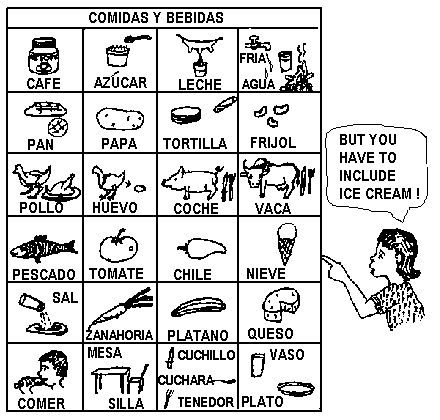
They drew pictures of these things on sheets of paper. To make it easier,
they started by drawing a single object on a sheet, and showed José one
drawing at a time. They asked him to point to the thing he wanted to have
or to say at that moment.
After practice with this, the team made communication boards
for different groups of things. One of the first boards they made was of
foods.
When considering which foods to include, Mari's daughter, Lluvia,
insisted that a drawing of ice cream be included. Mari thought
ice cream would not be one of José's priorities. "But what if he wants
it?" Lluvia insisted. So, ice cream was included.
When he began using the list, one of the first things José pointed to
was ICE CREAM. When it was brought to him, he laughed with delight.

With practice, José learned to identity most of the objects on the boards
and to recognize their names when spoken. He learned to use the board to
point to something he wanted, especially when he had trouble associating
it with the right word.
Later, to make it easier for him to carry his sheets of pictures, the
team reduced and reassembled the most useful drawings into a small
notebook that he could carry in his pooket.
During the days that José was at PROJIMO, his wife and Andrés used both
the picture boards and real objects to help him associate words with
things and actions. Although progress was slow, his communication skills
improved. Most important, perhaps, was that José and his wife were less
frustrated with one another and began to realize that they were both doing
their best. |
| 139
|
A DEAF MAN HELPS JOSÉ COMMUNICATE WITH SIGNS
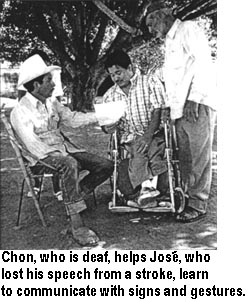
In helping José to re-learn to recognize words, it became clear that he
was quick to notice and interpret gestures and signs.
One day a deaf carpenter named Chon, who sometimes helps at PROJIMO,
saw Andrés teaching José with the picture board. Quickly understanding
José's difficulties with words, Chon began to explain things to José,
using signs and gestures. (Chon's sign language was not a standardized
formal system. It had been developed out of necessity, by him, his family,
and the villagers since he was a child. But Chon managed to communicate
and understand almost everything with remarkable clarity.) José picked up
on Chon's signs very quickly. This gave José's wife new ideas for
communicating with her husband. Everyone thanked Chon for his valuable
assistance, and he was delighted to have been able to help with his
expertise.
Helping José Learn to Walk Better
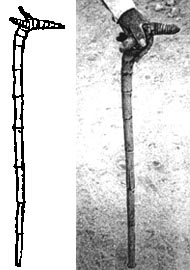
When José first came to PROJIMO, he walked with difficulty, using a
home-made cane made from a bamboo-like plant called otate. The
curved top of the cane was formed by the main root of the plant. Two
smaller side-roots provided additional supports for a firm grip.

For several weeks after his stroke, José's right leg was almost completely
paralyzed. Then, little by little, it began to recover strength. José
learned to walk again by bending the weak right knee slightly backward, in
a locked position that supported his weight without using his weak thigh
muscles.
This back-kneed gait caused him to walk awkwardly with short shuffling
steps, and with danger of falling hard if he lost his balance. (After his
stroke, José's balance was poor. Walking with his knee locked backward
made his balance and stability worse.)
|
| 140
|
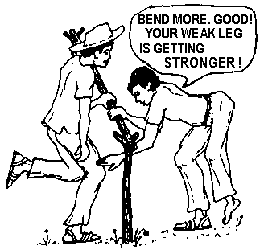
Improvement with Time. On testing José at PROJIMO 8
months after his stroke, the team found he had regained much of the
strength in his weak leg. He was able to partially squat on that leg
alone. With daily squatting exercises, the leg would probably get stronger
still.
Problem. José's right leg was now strong enough to let
him walk fairly normally. But the habit of locking his knee backward at
the start of each step was, by now, strongly fixed. Inez, a physical
therapy assistant at PROJIMO, encouraged him to bend his right knee while
walking. He had José practice shifting weight from one bent knee to the
other while he held onto a bar. Once José understood the request, he did
this willingly. But he still walked with a "back-knee." What to do?
A Partial Solution. Something was needed to help José
break his habit of back-kneeing and to relearn to bend his knee when
stepping with his leg. The team decided to experiment with a
leg-brace that would push his knee forward when he put weight on his foot.
Before making the plastic brace, Inez did a trial with a
plaster cast. The cast lifted the front of the foot slightly
upwards, so that when the foot was flat on the ground, the knee would
bend. However, this was not enough to prevent José from walking with his
knee pushed back (on his heel with his toes in the air). Therefore, Inez
mounted a metal bar in the cast under José's foot. The bar projected
backwards, behind the heel. This way, when José took a step with his right
foot, the heel bar would push the foot to make it land flat on the ground.
This would cause the knee to bend forward with each step.

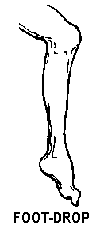
To make the heel bar removable and adjustable, Inez
inserted a flat iron bar into a thin-walled metal tube. He then hammered
the tube into a rectangular shape around the flat bar.
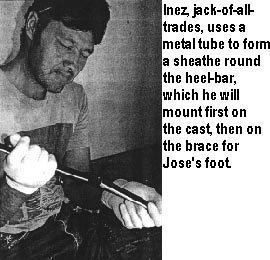
The experimental cast worked fairly well. Although José felt awkward in
it, he at once began to walk bending his knee, and soon he had a more
normal gait. The cast had the additional advantage of correcting the
foot-drop (front of the foot hangs down when the foot is lifted) which
remained after his stroke... Within an hour or so of practice, José put
aside his cane and began to walk with larger, more even steps. He was
delighted, although still somewhat disturbed by the cast. |
| 141
|
Casting José's Leg
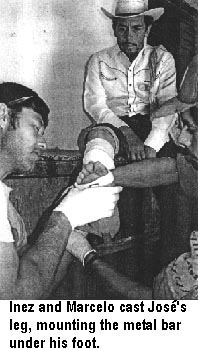

|
| 142
|

A plastic brace with an adjustable heel bar.
After demonstrating that the cast with the heel-bar helped José bend
his knee while walking, Marcelo made a plastic brace in which he mounted
the same bar. Because the experimental cast had bent José's knee forward
only slightly - and sometimes the knee started to bend backward - when
making the brace, Marcelo increased the ankle-angle so that the front of
the foot was somewhat higher.
José practiced with his new brace at PROJIMO for a few more days before
he and his wife went home. It is still too early to know the final
results. For the time being, José walks more evenly and with larger, more
regular steps. The team hopes that after a few weeks (or months?) with the
brace, José will become so accustomed to bending his knee when he walks,
that he will continue to bend it when he no longer wears the brace.

Adjustrnents. At the time of this writing, José had returned home
with his brace. As he gets used to walking with his knee bent, the
heel-bar can gradually be pushed deeper into the brace to make it shorter.

Depending on his progress, José may soon be able to stop using the bar
brace. For a while, he may need a modified shoe with the heel that sticks
2 or 3 centimeters out behind. This, too, will push his knee forward
gently, though less powerfully than does the long heel bar. |
|